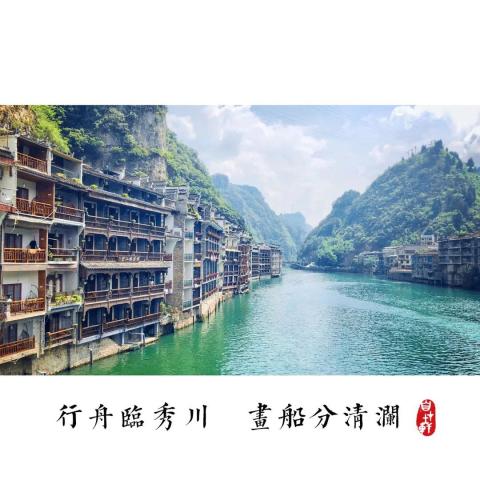
Zhenyuan Ancient City is also the seat of Zhenyuan County. Zhenyuan is known as "the key to Dianchu and the gateway to eastern Guizhou". History books say: If you want to occupy Dianchu, you must occupy Zhenyuan; if you want to connect Yunnan and Guizhou, you must first guard Zhenyuan. Because it is located on a traffic thoroughfare and the terrain is difficult, it is very important to take advantage of it, hence the name. According to "Guizhou Tongzhi": "In November of the sixth year of Baohu (1258), Emperor Lizong of the Song Dynasty, the Song Dynasty issued an edict: Huangping was newly built and named Zhenyuanzhou, and Lu Fengnian was promoted to the first rank." The name of Zhenyuan began here.
The ancient streets and lanes in the city are winding, the stone bridges and city walls are well-proportioned, the clear water and morning mist are various, and the Spring River fishing fires are full of poetry... The ancient houses, lanes, docks, city walls, etc. from the Ming and Qing Dynasties are worth seeing. tourist attractions.



Every piece of bluestone records the past glory of the thousand-year-old city. Zhenyuan is not large in scale. The Wuyang River meanders through the city, with the original Fucheng on the north bank and the original Acropolis on the south bank.




Tianhou Temple

The "Shiping Giant Town" Shipai Fang Ancient Town stands at the entrance of the pedestrian street. This pedestrian street is also the only avenue in the ancient town. The winding alleys on the north side of the street connect the pedestrian street to the ancient residences of the Ming and Qing Dynasties at the foot of Shiping Mountain.







Zhenyuan used to have six lanes and ten lanes, but now there are nine ancient lanes preserved in the ancient city. The ancient lanes follow the mountains, winding and circling with the changes of the terrain, and are intricate.



The "crooked door and ramp" is a unique feature of Zhenyuan's ancient houses. The doors of the houses beside the alleys will never be parallel or perpendicular to the alleys, and the alleys will never be directly opposite the halls. The doors are intentionally tilted. Facing the street diagonally.






Wuyang River divides the city into two parts. On the north bank is Fucheng, backed by Shiping Mountain. There are ancient buildings of Ming and Qing Dynasties on the hillside. On the south bank of the Acropolis, there are several miles of remaining walls and two towers. The consecration bridge on the river has a great origin.




The above is the Qinglong Cave ancient building complex built on the mountain but suspended in the air. This is a group of buildings that are mainly based on "Tao" and are compatible with Confucianism and Buddhism. Wanshou Palace is also the seat of Jiangxi Chamber of Commerce.

The Zhusheng Bridge was last restored in the first year of the Yongzheng reign of the Qing Dynasty. When it was completed, it coincided with the Christmas of Emperor Kangxi. It was renamed the Zhusheng Bridge in order to celebrate the birthday of the emperor. There is a three-story pavilion with double eaves and octagonal spires on the Zhusheng Bridge, which is called Kuixing Pavilion. Because students from Yunnan and Guizhou must pass through the Zhusheng Bridge when they go to Beijing to take exams, the people also call it the Zhuangyuan Pavilion.

There are three couplets in Zhuangyuan Tower, among which "Sweeping away the smoke from the Wuxi River, the Han envoys came out with buckets; opening up a heavy post road, and the Burmese people rode elephants to cross the bridge" is the most famous. It not only shows that the consecrated bridge was an ancient Yunnan and Guizhou bridge at that time. The important passage on the post road is also strong evidence that Zhenyuan used to be an important town on the Southern Silk Road.
During the Anti-Japanese War, the Hunan-Guizhou Highway was opened to traffic. As the continuation of the Yunnan-Burma Highway, the Zhusheng Bridge is the only way to pass through the Hunan-Guizhou Highway and has become the backbone bridge on the Southwest Passage. Trucks transporting strategic materials pass over the bridge every day and rush to the anti-Japanese front line, making important contributions to the Chinese people's victory in the anti-Japanese war.

Walking along the Wuyang River, you can see beautiful mountains and green waters, shaded by green trees. The green decoration of the ancient city is extremely comfortable. Walking on the plank road by the river, the river breeze blows slightly, making people completely forget about the heat of summer.
